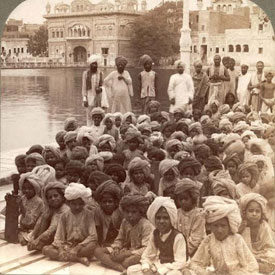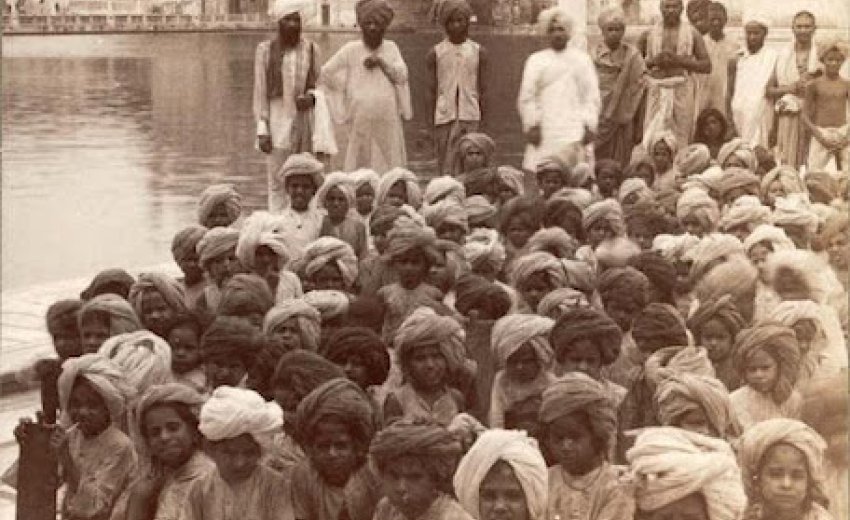ON SECTS & DENOMINATIONS IN SIKHI
Recently a gurduara in North America ran into a problem. It wanted to sponsor a religious worker from India. There may be ways to circumvent the law but they were told that it required the beneficiary and the petitioner to certify that both belong to the same religious denomination or sect of the religion for at least two preceding years.
So far so good until the petitioner claimed that Sikhi has no denominations or sects. Mind you, I have heard the same passionately framed formulation from many dedicated Sikhs and scholars of Sikhi over the years.
What constitutes a denomination or a sect in a religion and does Sikhi have any? That’s the question. Is it true that Sikhi has no sects?
First let’s define some terms. In practice many, if not most, critical concepts in the study of most, if not all, religions lack precise definitions.
Religion then becomes the belief system, whatever it is, of the writer or the reader. Convention further mandates that a given system or “religion” be in place for a certain indeterminate length of time measured in span of centuries or at least several decades at the minimum to be seen as an independent faith or religion.
The humorist Leo Pfeiffer summed it thus: “If you believe in it, it is a religion or “the” religion; if you do not care for it one way or the other about it, it is a sect; but if you fear and hate it, it is a cult.” Cults are fearsome entities that remind us of Manson and Jim Jones. The word “cult” is a derogatory term, and it remains difficult or impossible to redeem it of its evil connotations since the 1930’s. In Sikhi it reminds us of the slew of “Babaas and Deraas” that increasingly continue to dot the countryside of Punjab in India.
In my view any system, whether of civil government or religion, in time, spawns contrary and differing interpretations and modifications in models and practices. If it stays within the larger framework of “the religion” it becomes a sect or a denomination; if it sunders all connection with the parental fold it morphs into a new religion.
History tells us that many Jews accepted the Jewish born, Jesus, as the promised Messiah, though many more Jews did not accept him as such and still await one. This gave birth to a movement “Jews for Jesus” that was fairly substantial 2000 years ago but regressed with time. It still exists but is now minuscule.
But those that accepted Jesus as the Messiah have become a worldwide, powerful presence – Christianity -- that is now so large and so clearly and separately defined from its parent religion of Judaism that no one would label it a sect, denomination or reform movement within Judaism. It would be asinine to do so.
Christianity is now an unquestionably separate religion from Judaism with clear differences in belief, practices, religious rites, creed or statement of faith, worship services, formal or informal code of doctrine and discipline, as well as its ecclesiastical structure and governance.
Sikhism, though the fifth largest faith of mankind, is a relatively small religion of about 25 million worldwide and is also one of the youngest, having started only a little over 500 years ago.
There is no doubt that the core beliefs of Sikhi are unique and dramatically different from Hinduism and Islam that were and continue to be its largest and most influential neighbors in India. I would say that in India Sikhism exists as a drop in the sea of Indian (largely Hindu) mythology and worldview. Yet it is eye-opening to see how Sikhi’s worldview and social practices that were so mixed with Hindu cultural practices have evolved so clearly into a vision that is entirely separate from that of its neighboring faiths. More importantly, I would assert that this evolutionary process continues unabated even today.

Denominations and cults are, to my mind, inevitable with time. I point out that Christianity today boasts of over 250 denominations – although I have also read of the number being larger than a thousand.
Sikhi, too, has not escaped the process. Our “Deraas and Babaas” are often evidence of cults that remain within the larger framework of Sikh practices, doctrines and beliefs.
There are also a few, less than a handful of reform movements in Sikhism that might merit the handle of denominations. Pre-eminent among them are the Namdharis, started by Baba Balak Singh in the early 19th century. His premise was a major disagreement and fundamental split with the larger mainstream of Sikh doctrine on whether the line of Gurus in human form ended with Guru Gobind Singh in 1708 or not. The larger body of Sikhs believes that it did, Namdharees believe that the line of living Gurus in human form continues unbroken even today.
Nevertheless, even the Naamdharees have a significant and continuing contribution to Sikh sacred music. They attend the same places of worship (gurduaras) as the mainstream Sikhs do, and observe the same requirements of the faith except the one noted above. Intermarriages between the two factions are common. The teachings, doctrines and observances remain the same with the one significant exception noted.
In the light of the above it is easy to posit that Naamdharees are not a different religion. One could argue that they are a distinct denomination or sect but, significantly, it is not so easy to make a convincing case for that proposition either.
Similar situation holds as far as Radhaswamis or Ravidasis are concerned.
I remember when Yogi Bhajan’s movement took hold in North America beginning in the early 1970’s. All of a sudden there were a large number of converts to Sikhism, largely White Americans of North-West European ancestry. They spoke little Punjabi and had only a rudimentary perception of and connection to Punjabi Sikhs -- their language, music, cuisine or culture. Many were survivors of the wild and tumultuous 1960’s.
I remember when Punjabi Sikhs would taunt these “Yogi” converts with the challenge: “Are you Sikhs of the Guru or of Yogi Bhajan? Now a generation later, good sense has prevailed -- the divide has been largely spanned and these converts are no longer seen as aliens from outer space; they are welcomed and increasingly well integrated into the wider world of Sikhi. They, too, are bound by the same ways, teachings and traditions of Sikhi as any other Sikhs. Yet, they show departures in some practices, notably their insistent practices of yoga and vegetarianism.
Perhaps we are still at the stage where we do not see any visible sects or denominations within Sikhi. As I stated at the start of this essay, for immigration and sponsorship purposes the question that remains is only whether a Sikh has been a Sikh for at least two years.
At this time this matter is not so difficult to answer. Sikhi is not an actively proselytizing faith, although it welcomes converts who wish to join us. But we do not spend time, energy or resources diminishing other faiths in order to convince them of the errors of their ways.
For immigration sponsorship of religious workers apparently all that we need is for a person to submit a sworn and attested affidavit as to his Sikh status – by birth or by conversion, supported by statement of when and where the conversion occurred.
Now a post script: Keep in mind that I started with the immigration lawyers coming back with the requirement that both the candidate and the sponsors belong to the same denomination of Sikhi. They named four different branches of Sikhism -- Orthodox, Udasi, Keshadhari and Sahajdhari -- and wanted to specify the commonality of denomination for both the sponsors and the candidates.
I am not sure where the lawyers for the Immigration Service got this classification. To me it surely is a false dichotomy. All so called “Orthodox” Sikhs, by definition are Keshadhari; Udasis may or may not be. I am not sure that Udasis are in the mainstream of modern Sikhism. I am not even sure that they form a distinct sect of Sikhi. Keshadhari here means those who maintain long unshorn hair; this term does not necessarily insist on any other requirements of the faith.
All religions have followers where some individuals are more observant (orthodox) than others. In some, like the Jews, the division becomes more formal and one could label them denominations or sects. (I am not sure if Jews would accept my reasoning in this matter.) Such differences do not constitute denominations in most religions, including the Sikhs. In Christianity the split between the Roman Catholics and the Protestants shows a fundamental doctrinal divide; thus the separate identities of these two denominations (sects) are etched in stone. Over time, Christianity has spawned many more.
I would divide Sikhs into three categories (not officially recognized denominations): 1. Amritdharis, 2. Keshadhari but non-Amritdharis, and 3. Sehajdharis. But these are not separate denominations or sects. Both 1 and 2 are Keshadhari since they have long unshorn hair. Sehajdharis, for whatever reasons, are not long-haired Sikhs. They may have been raised that way or may have cut their hair for whatever reason that suited them. Nevertheless there is no separate denomination or sect of either. All avow the same edicts, traditions, doctrines and practices. All of them attend the same places of worship and live by the same rituals and traditions. The same institutional structure governs them.
So where do we end up? Are there denominations or sects in Sikhi or not?
September 24, 2015





